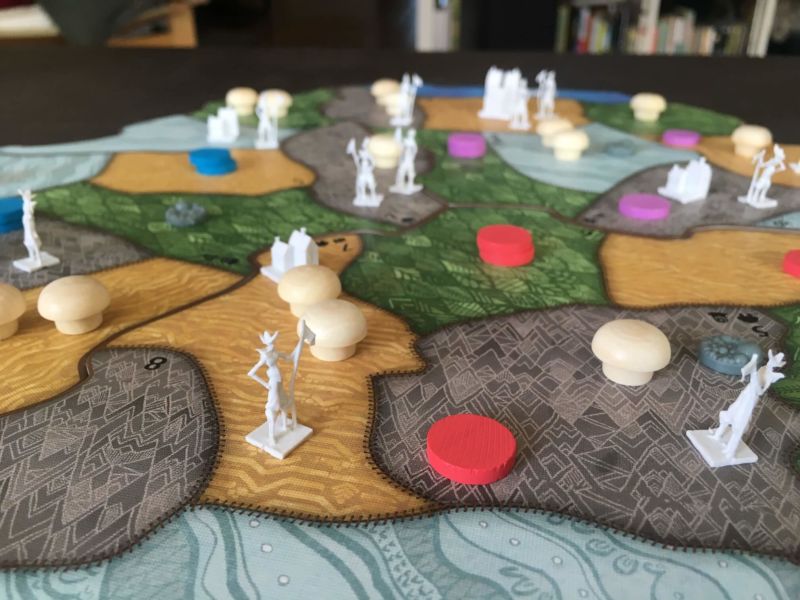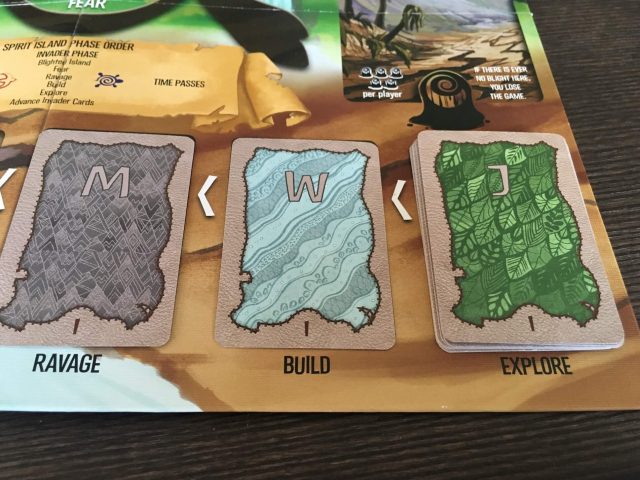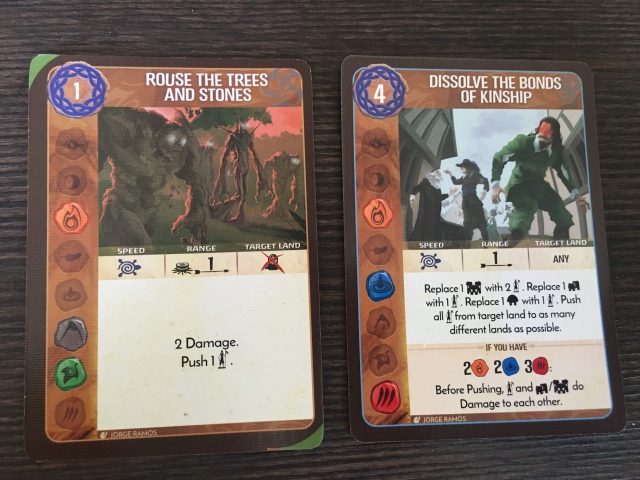
A side effect of Euro-style board games’ preoccupation with European history as a theme is that many such games hinge on colonialism. Most board games are not “pro-colonialist,” of course, but simulating a long history of European imperialism necessarily means that a lot of us sit around on game nights trying to figure out the most efficient way to exploit the resources (and sometimes, uncomfortably, the people) of a newly “discovered” land.
Spirit Island, a cooperative strategy game for one to four players, flips this well-worn script on its head. Instead of playing as settlers building out villages and roads in a new land, you and your friends take on the role of god-like elemental spirits charged with protecting the island's various landscapes from those pesky invaders, who are controlled by the game itself. It’s kind of like a complex, wildly asymmetric Pandemic—but here, people are the disease.
The island's natives are there to help you fight back when they can, but it's mostly up to you and your teammates to destroy the settlers' fledgling cities, remove the blight they introduce as they ravage your pristine lands, and gain more and better powers to help you on your way. Gameplay is driven by cards, and as the game progresses, you'll get more and better powers and strike more and more fear into the invaders' hearts. Drive them off to win.
Spirit Island follows the template of most co-op game engines, with each round allotting a phase to the players during which they can mount an attack against the game’s machinations.
Then, of course, the game gets a turn.
-
Spirit Island is a game where you protect an island from colonialist invaders.
-
A 3-player game in action. The white plastic pieces are enemies; the wood pieces are friendly.
-
The opposite sides of the island boards feature prettier, although much less functional, art.
-
The invaders include explorers, towns, and cities.
-
The Dahan are friendly native islanders who help you fight.
-
Players take on the role of protective spirits, whose presence is represented by wooden discs.
-
Here's a player board for one of the beginner-friendly spirits. At the top are your options for character progression, in the middle are tracks for energy generation and card plays, and at the bottom are spirit-specific special abilities.
-
The back of the player boards show the spirit's strength and weaknesses, along with a guide to the spirit's complexity.
-
-
Eight spirits are included in the game. They each play wildly differently.
-
-
The invader board tracks what the invaders will do each round—and the fear you are striking in their hearts.
-
As the invaders become more afraid, your victory conditions change.
-
Blight. Not good.
-
Functional inserts? In my board game?!
-
Scenarios and adversaries provide extra variability—and crank up the difficulty considerably.
Firestarter
The invaders first enter the island as explorers, represented by spindly little miniatures armed with flags and conquistador helmets. They then build towns and cities, which bolster their strength in the map’s various segmented landscapes. Then, presumably due to underdeveloped carbon footprint reduction programs, they ravage the land. Ravaging causes blight, represented by plastic tokens taken from a supply that’s assembled at the beginning of the game. If the invaders cause enough blight to wipe out your supply, you instantly lose.
Of course, this being a co-op board game—a genre that prides itself on cultivating a sadomasochistic relationship with its players—there are actually three ways to lose. In addition to death-by-blight, you can also lose by letting the invaders wipe one of the player-controlled spirits off the island. Or you can simply run out of time—in this case by burning through the “invader deck.”

Co-op game engines generally drive the action by starting fires each round that you need to put out as quickly as possible. There’s never enough time to do everything, of course, so you have to prioritize disaster response to the most pressing matters. Spirit Island keeps this general setup, and the game’s invader card track ensures you know what’s coming every round. The invaders are going to ravage in the mountains next turn, but they’re building in the wetlands, which are already being overrun. Do you take the blight hit to work on hampering their expansion?

The game boasts complexity and depth rarely seen in one-and-done co-ops. Figuring out how to manage the ever-expanding mass of invaders requires you to constantly think several turns ahead. Deciding how to play your cards is a wonderfully thinky puzzle and easily the best part of the game, but again, it’s complex. Players prone to “analysis paralysis” may feel the gears in their heads grinding to a halt as they work out all the possible permutations of actions—and how to combo their actions with those of their teammates. Cooperation is essential here, and that cooperation can compound the complexity (and play time).
Build-a-spirit
Co-op games are wildly popular in board gaming. They allow players to work together to overcome a common threat, which is perfect for players who don’t want to fight their friends in their free time. Personally, I’ve never been much of a fan.
Competitive Eurogames almost always allow you to build stuff, whether that’s something concrete like a kingdom made of tiles or something more abstract like an economic engine. At the end of a competitive Euro, win or lose, you have something that you've built. If you lose a co-op, which you often will (co-ops are hard by design), you… just kinda lose. If you win, it generally means you’ve successfully limped across the finish line after spending 90 minutes fighting for every breath.
Spirit Island bridges this gap for me by letting me build something: my spirit. Every single round, your spirit gets better. At the beginning of the round, each player gets to choose between three or four “growth” options for their spirit. Many of them allow you to move a disc or two off tracks on your player board and put them on a landscape on the central board. As you uncover spaces on those tracks, you gain access to more energy (think “mana”) and extra card plays.
By the end of the game, you feel like a literal god, playing cards to push invaders around the map with violent waves and explosive volcanoes, setting traps and watching as a teammate detonates a perfect combo that wipes out an entire metropolis. Later rounds see the invaders exploring and ravaging multiple lands every turn, which provides for a great sense of progression. You get stronger and stronger, and the invaders start frantically throwing more bodies at you as they get increasingly desperate. This is far from the only co-op game with an emphasis on character progression, but the narrative arc of each game feels especially satisfying here.

When you get new cards, you draw four from one of two decks and choose one. There are minor and major powers; the majors are naturally more powerful, but they’re also more expensive to play—and they force you to forget (discard) another card from your stock. One of the growth options lets you reclaim your played cards at the expense of slowing down your growth on the board, so choosing the right moment to take a tempo hit to get all your goodies back is essential.
The spirits themselves—there are eight included in the base game—all play completely differently from one another, with different starting cards, growth options, special powers, and even wildly different energy generation and card play potential. Play to your strengths, shore up your friends’ weaknesses, and draft cards that work well in your team composition.
Spirit Island also plays surprisingly well as a solo game, though playing with one spirit is about all I can handle—the cognitive load required when playing as two or more spirits is… heavy.
The variety of spirits, a bunch of randomized power cards, and a variable setup mean there's a ton of replayability in the box, while scenarios and country-specific adversaries introduce new rules and let you scale up the difficulty. The game is always hard, but you can make it very hard if you're really itching for punishment. And if you burn through the base game’s content and want even more options, the Branch and Claw expansion adds two new spirits, a new adversary, and new powers, cards, and scenarios.The game's MSRP of $80 is a bit high, but if you're at all interested in co-ops with a cool theme and even better gameplay (and you're not afraid of doing a bit of thinking), Spirit Island is an easy recommendation. It was one of our favorite games of 2017, and we're still playing it obsessively.
reader comments
61